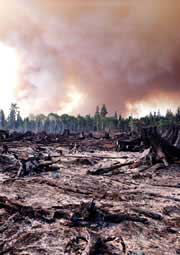COLD safer than HOT

Fires can devastate HOT forests. <br>© Getty Images <br>
New theory shows that high performance needn’t mean high risk.
For man-made systems such as machines and markets, catastrophe lurks somewhere between high risk and high performance. US physicists may have found a way to strike the optimal balance1.
This trade-off is familiar to the financial world. Brokers develop investment portfolios to provide the best returns within a specified level of risk. Mark Newman and co-workers at the Santa Fe Institute in New Mexico have borrowed some ideas from the economic theories of risk aversion to create a general prescription for avoiding ruin.
As a simple model of a system where productivity is coupled to risk, the researchers considered forest management. A forester wants to plant trees densely enough to produce a high timber yield. But the denser the trees, the more susceptible a forest is to devastating fires. So forests include open spaces to limit fires.
In 1999, researchers showed that complex systems like this often have states of ’highly optimized tolerance’ or HOT2,3. In a HOT state, performance (tree yield, in this case) is as good as it can be, in the face of influences (such as forest fires) that potentially undermine it.
But a HOT system has an Achilles’ heel. It is typically fragile under perturbations for which it was not designed. For example, if the distribution of fire breaks or sparks alters slightly, a forest can become highly susceptible to fires and give a poor yield.
Newman’s team now points out that HOT designs have another drawback. The cost of an optimal performance is a high chance of a ruinous collapse. Catastrophic fires that burn nearly all the trees are rare, but not as rare as one would expect if fire size were random. The optimal state is a high-risk state: it gives good returns at the price of possible ruin.
Most engineers don’t want to run this risk. So Newman’s group has calculated how to design a system to optimize performance and almost eliminate the probability of ruinous events. They call this design principle ’constrained optimization with limited deviations’, or COLD.
Surprisingly, a COLD state can completely remove the danger of total ruin while sacrificing only a few per cent of the average yield relative to a HOT state. Newman and colleagues say that, as we are generally risk-averse, we are more likely to prefer COLD designs than HOT ones.
Nature, apparently, is more short-sighted. Ecosystems, for example, are often in HOT states They are catastrophically susceptible to rare disturbances not accounted for by natural selection – such as meteorite impacts.
References
- Newman, M. E. J., Girvan, M. & Farmer, J. D. Optimal design, robustness, and risk aversion. Preprint, (2002).
- Carlson, J. M. & Doyle, J. Highly optimized tolerance: a mechanism for power laws in designed systems. Physical Review E, 60, 1412 – 1427, (1999).
- Carlson, J. M. & Doyle, J. Highly optimized tolerance: robustness and design in complex systems. Physical Review Letters, 84, 2529 – 2532, (2000).
Media Contact
More Information:
http://www.nature.com/nsu/020225/020225-3.htmlAll latest news from the category: Physics and Astronomy
This area deals with the fundamental laws and building blocks of nature and how they interact, the properties and the behavior of matter, and research into space and time and their structures.
innovations-report provides in-depth reports and articles on subjects such as astrophysics, laser technologies, nuclear, quantum, particle and solid-state physics, nanotechnologies, planetary research and findings (Mars, Venus) and developments related to the Hubble Telescope.
Newest articles

Why getting in touch with our ‘gerbil brain’ could help machines listen better
Macquarie University researchers have debunked a 75-year-old theory about how humans determine where sounds are coming from, and it could unlock the secret to creating a next generation of more…

Attosecond core-level spectroscopy reveals real-time molecular dynamics
Chemical reactions are complex mechanisms. Many different dynamical processes are involved, affecting both the electrons and the nucleus of the present atoms. Very often the strongly coupled electron and nuclear…

Free-forming organelles help plants adapt to climate change
Scientists uncover how plants “see” shades of light, temperature. Plants’ ability to sense light and temperature, and their ability to adapt to climate change, hinges on free-forming structures in their…





















